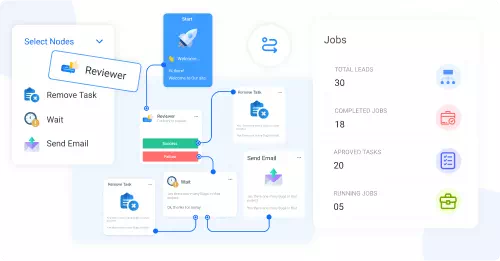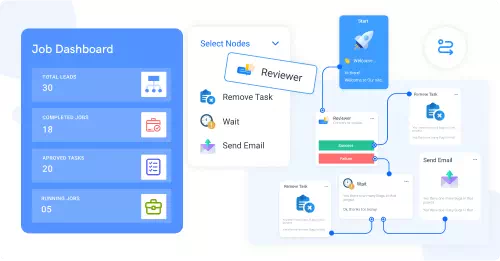What is the Need for Automation In BPM?
BPM involves the consideration of the required processes, the analysis of workflows in a way that optimizes and implements the necessary changes.
#1
Unlimited Process Automation
#2
No-code Process Modelling
#3
Notifications and Triggers
#4
Auto Execute Capability
#5
Integrate with over 8 Apps Including Gmail
#6
Effective Form Designer
#7
Pre-built Automated Flows
#8
Intuitive, Drag-and-Drop Process Designer
#9
Unbelievable pricing - the lowest you will ever find
#10
Everything your business needs - 50 apps, 24/5 support and 99.95% uptime
Many organizations understand the need to automate business processes (BPA ), but when implementing the required solutions some of these implementations are ascribed to lack of time or financial constraints while others do not recognize the associated ROI. Business process automation can make an organization optimistic when it understands that it will facilitate its work, but it is still a ball game when it comes to implementing such an approach across the company. BPM involves the consideration of the required processes, the analysis of workflows in a way that optimizes and implements the necessary changes.
In the 1980s and 1990s, companies began computerizing their processes and automating basic repetitive tasks, and the trend towards standardizing and optimizing tasks evolved into Business Process Management (BPM ). BPM is a discipline that helps companies optimize processes to become more efficient, rational and adaptable to changing conditions. Business Process Automation (BPA) tries to automate repetitive tasks that require manual intervention, such as employee boarding, file transfers, report creation and distribution, approval processes and much more.

BPM does not include automation itself but is a subset of infrastructure management that maintains and optimizes key operational components of an organization, such as processes, equipment, and data. BPM identifies and improves processes to make companies more efficient, disciplined, and able to adapt to changing conditions. What BPM can not include is the automation of business processes, not only to reduce the error rate and increase the efficiency of workflows, but also to clarify roles and responsibilities of workplaces, and increase the ability of companies to adapt quickly to changing business objectives.
BPM is an overarching strategy aimed at automating entire workflows. BPM technologies and Business Process Management are the best allies for controlling process automation and should be implemented throughout your organization.
BPM is a business process that helps streamline the management of workflows and improve the efficiency of manual and automated activities. BPM does not include automation but uses a variety of methods to discover models, analyze changes, and optimize end-to-end business processes. BPM solutions are not only used to improve workflows but also to increase the efficiency and productivity of the entire organization, unlike BPA software.
BPM is an end-to-end solution that automates the entire business process, while RPA is a technology that complements a solid BPM approach. BPM is a holistic approach that optimizes and automates business processes while RPA takes on discreet and repetitive tasks. These tasks occur at the beginning of the process, and RPA plays an important role in their automation.
While RPA is an automated tool that can play a role in a broader strategy and technology to automate automation processes, BPM also plays a role. BPM brings a new process discipline to the organization, which is of considerable value both from the perspective of digital transformation and from the perspective of business improvement.
Decision-makers can use automation of business process management to find inefficiencies in current workflows, find ways to improve them, and deploy monitoring tools to monitor project management workflows. In short, process automation in BPM can be used to visualize workflows and consider the measures required to implement them. By automating processes, BPM software management can detect in real-time what is happening in a workflow.
Mapping improves the process flow because there are several ways to automate certain tasks. One of the biggest advantages of Business Process Automation ( BPM ) software is the automation of paper-intensive and manually driven processes to streamline processes. Business automation reduces the need for human resources for repetitive and monotonous tasks such as invoice payments, website analysis, and simple tasks such as converting paper forms into electronic forms.
Processes and workflows that are well structured and repeatable make the best candidates for automation. This gives you a clear picture of how processes within an organization can be automated.

- For medium to complex processes, traditional BPM tools are often more advanced than low-code tools of modern application development platforms. These platforms not only focus on BPM, but also offer a range of tools that cover a wide range of use cases, including process management, eliminating some of the complexity of BPM software. While BPM software and BPA tools are both comprehensive, a BPA tool can be used to automate one or more activities in a process.
Conclusion:
The automation of business processes (BPA) helps companies streamline processes such as employee onboarding, payment obligations, contract management, and much more. BPA automates various processes so they don't require logical thinking, and allows employees to engage in tasks that require more creativity and human touch, lowering the overall cost of running a business. RPA is known for helping labor-intensive organizations automate manual processes.
Developing, creating, automate and integrating Business Processes (BPMs) enables companies to save time and reduce costs by streamlining daily manual processes with easy-to-use, efficient, and traceable electronic processes. The technology, which enables the automation of complex business processes, consists of integrated applications that restructure labor resources across the company using software applications.
Consolidating a solid foundation of tools for orchestrating processes and automating tasks and processes across all business processes on a single platform allows them to move away from decommissioned automation tools with limited capabilities (such as point planners) to develop orchestrated automation strategies that facilitate cross-company processes and provide greater transparency, insight, and innovation. Some argue that ERP systems have the advantage of managing process automation and management that do not require intensive coding resources or long project schedules, as many BPM software systems do.





